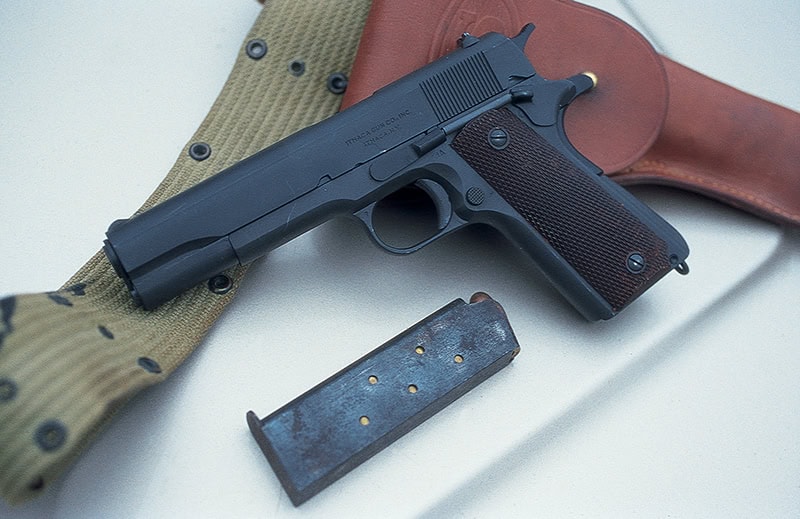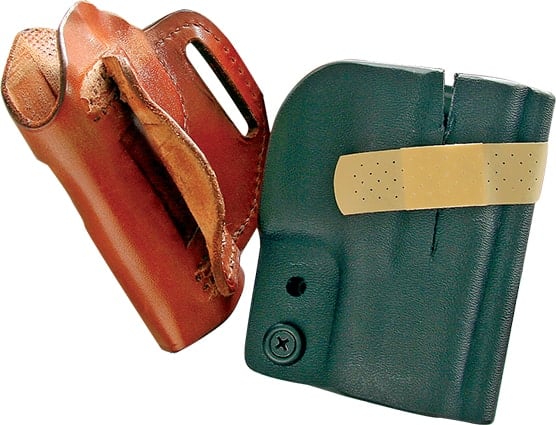How Long Is Too Long?
For those of us who carry or use semi-auto pistols for serious purposes, the question of how long it’s “safe” to leave your magazines loaded has always been an issue. My recommendation has always been to rotate your magazines every six months, and never leave duty or self-defense magazines loaded for more than one year.
How long can pistol magazines be left loaded and still be reliable? Let me tell you about an interesting loaded magazine that just came my way. One of the “Greatest Generation” had passed away, a former Navy Seabee who, upon returning from the South Pacific in 1945, put his GI 1911 on a closet shelf in condition three. After his death, the family chose to dispose of this great old .45. Wayne Novak ended up with the pistol, a well used Union Switch & Signal M1911A1, complete with GI pistol belt and holster. The magazine kept in this pistol had been loaded with 1941 dated Remington ammo for the past 57 years.
Wayne showed me the pistol and offered me the magazine, still loaded with these tarnished old rounds. Wayne said, “Why don’t you see if it still feeds reliably.”
Made In The U.S.A.
After 57 years of the spring being compressed, coupled with the age of the ammo, would this magazine work? Not odds one would wish to stake his life on, but I felt it would be an interesting test. Is it all, indeed, much ado about nothing. Or is the problem of spring-set a real one?
Off to the range with a select M1911A1 Ithaca GI pistol. I gently inserted the old magazine into the pistol. It showed signs of rust inside the feed lips and a brown patina, but seemed serviceable. After cycling the slide, I took aim at a target 15 yards down range and smiled. My old eyes struggled with the small hump and bump sights, but with seven presses of the trigger the old gray ghost blasted a nice, fist-sized group through the target. Not one bobble — and the slide locked to the rear on the last shot. Damn, 57 years loaded with ammo that was 61 years old and it went bang every time.
Testimony to good old “Made in the USA.”
After shooting the seven rounds of GI ball, I checked the magazine out. The spring was very weak and certainly had taken a set. If this pistol had not had the original GI 16 pound recoil spring that allowed the pistol to cycle slowly, the pistol may not have functioned as well as it did. I would bet had I used this mag and ammo in a Colt Officers ACP, with extremely fast cycle time, reliable function would not have been the case.
In the early 1960s, my uncle gave me a Luger he brought back from the Second Great Hate. It too had both the primary and spare magazine loaded and had been that way from the date he returned from Germany in 1945. I took it to the range and tried to shoot it with the original loaded magazines and it was choke-city, failing to function, with many stoppages. Is the Luger magazine design less reliable than the 1911? Remember, the Luger had been loaded for only 25 years, but the toggle action of the P08 is extremely fast cycling. Perhaps the relaxed spring of the Luger magazine could not feed the rounds up fast enough to beat the forward movement of the bolt.
Different pistol designs result in different action dwell times. Don’t assume that because a pistol works well with magazines left loaded for years it is going to be the case with all models and designs.
The Golden Rule
My recommendation, and the rule I try to follow with my own pistols, is to leave them loaded for six months or so, then rotate them with fresh magazines. Then, let the springs recover and rest. If you have only two or three magazines for your favorite blaster, this is another reason to add a couple of spares to your pile. Mark your magazines with numbers or letters so you know which ones are to be rotated. Don’t risk your life on the bet your mags and ammo will still work after years of storage while loaded. I have to admit I was very surprised and pleased to see this fine old war horse M1911A1 magazine come through with flying colors. I think I will clean it up, maybe replace the spring with a fresh one and let it carry on with occasional trips to the range. I don’t intend to replace my Wilson Combat magazines for my serious use, but every time I pull this old WWII mag out and use it, I’ll feel an appreciation for J.M. Browning’s design and the soldier who carried it.
Long before CAD-CAM machines, or high speed photography and x-ray technology, John Moses Browning figured it all out in the computer between his ears — and he did a pretty fair job of it.

Get More Personal Defense Tips!
Sign up for the Personal Defense newsletter here:






